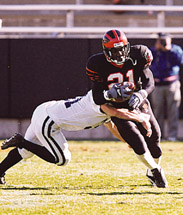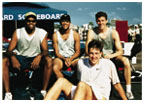December 5, 2001: Sports
Great
performances, a little too late
Tigers finish season with two strong wins
Playin'
pickup with His Airness
Alumni helped Michael Jordan back into playing shape
Sports Web Exclusives! The Varsity Typewriter column
Great
performances, a little too late
Tigers finish season with two strong wins
By Jerry Price
Photo:
After a quiet week versus Yale, Chisom Opara ’03 came up big with
nine receptions for 149 yards and two touchdowns against
Dartmouth. (Beverly Schaefer)
Princeton’s
football team had only one problem when the sun began to set on a perfect,
late fall afternoon November 17 in Hanover, New Hampshire: The next game
was nine months away.
Princeton finished the
2001 season on its highest note in six seasons, ripping Yale 34—14
and Dartmouth 35—14 in the final two weeks. The wins snapped a five-game
losing streak and helped the Tigers finish 3—6. Their 3—4 record
in the league tied them with Columbia for fourth place.
“It’s a shame the season is ending,” said wide receiver Chisom Opara ’03. “We’re really playing well now.”
Princeton’s two big wins ended all sorts of streaks, beginning with a 34-game run, dating to 1998, since Princeton had won back-to-back. Beyond that, it was the first time since 1992 — a span of 94 games — that Princeton had scored at least 34 points in consecutive weeks. It was also the first time since 1991, going back 104 games, that Princeton had had back-to-back 20-point wins.
“We said we were going to play hard to the end, and we did,” said quarterback David Splithoff ’04. “We said we had a lot to play for in the last two weeks. We’re excited about where we are now.”
It was an odd season for the Tigers, who were literally inches away from winning two other Ivy games (Harvard, Cornell) and a few plays away from winning the other two (Penn, Brown). The Tigers lost by two at Harvard against a team that would go unbeaten and led Penn, who went 8—1, in the fourth quarter.
As shown by its late-season performance, this is a team geared for the future. Eighteen starters will return from this season, including eight who have already started for two seasons.
“It feels good to know that I’m leaving my career on a high note,” said senior linebacker Bob Farrell, one of four senior starters. “And it’s good to know that we’re leaving the younger guys in such good shape.”
At the final home game on November 10, Yale jumped out to a 14—0 lead and appeared to be going in for more in the second quarter when Brandon Mueller ’04 intercepted a pass to stop a drive. By the time Princeton honored Dick Kazmaier ’52 and the undefeated teams of 1950 and 1951 at halftime, it was 14—14; by game’s end it was no contest.
Splithoff passed just 11 times, but he completed seven for 166 yards and two touchdowns. Freshman B. J. Szymanski, who had two catches all season heading into that game, had four for 140 yards and two touchdowns. Cameron Atkinson ’03 returned from a knee injury to rush for 138 yards and two touchdowns.
“This is how we’re capable of playing,” Atkinson said after the game. “This is how it should always be for us.”
The season-ender also featured a sub-plot: the return of head coach Roger Hughes to Dartmouth, where he spent eight seasons as offensive coordinator. “I’d be lying if I said it wasn’t going to be different,” Hughes said before the game. “I’ve never been in the visiting locker room. I’ve never stood on the other side of the field except at the spring game.”
Hughes, still stinging from a 42—37 loss in Princeton to Dartmouth a year earlier, had no complaints on this day. Princeton dominated the Big Green, leading 14—7 at halftime and blowing it wide open after that. Splithoff had another huge day, completing 16 of 28 passes for 291 yards and two touchdowns to Opara. Splithoff has 12 career touchdown passes, seven of which have been for at least 50 yards. Freshman Jon Veach replaced a re-injured Atkinson to rush for 108 yards and a touchdown. Sophomore linebacker Zak Keasey, perhaps Princeton’s best player over the final three games, had his third straight double-figure tackle game with 10.
“Anytime you can generate this kind of momentum heading into the off-season, everything’s positive,” said Hughes. “The kids have had a taste of success now.”
The negative is that it’s
going to be a while until they have a chance to build on it. Still, for
a program that has struggled for six years, the last two weeks of the
2001 season were extraordinary. ![]()
Jerry Price is assistant director of athletics.
Field hockey made it to the
NCAA Final Four before losing in the semifinal to Michigan, 4—2.
Women’s soccer lost in the second round of the NCAA tourney to Rutgers,
1—0. At press time men’s soccer was awaiting its tournament
pairing. Look for more coverage in the December 19 PAW. ![]()
 Playin’
pickup with His Airness
Playin’
pickup with His Airness
Alumni helped
Michael Jordan back into playing shape
By Mark F. Bernstein ’83
Photo: Superstar Michael Jordan played pick-up with Craig Robinson ’83, above left, and John Rogers ’80, above right, while preparing for his comeback.
Basketball fans have seen the great Michael Jordan in several incarnations over the years. First, there was Air Jordan, who soared over defenders for majestic dunks. Later, there was Jump Shot Jordan, whose famous 18-footer clinched a sixth NBA title for the Chicago Bulls in 1998.
Is the NBA ready for Backdoor Jordan?
Maybe not, but if you happen to see the Washington Wizards’ new star spring Princeton’s trademark play this season, remember that he learned it from masters: former Tiger stalwarts John Rogers ’80, Craig Robinson ’83, and Mitch Henderson ’98. The trio was among a select group of players invited to practice with Jordan last winter as he began to contemplate a comeback. They learned a lot and perhaps taught a little, too.
“He ran [the backdoor] like he’d gone to Princeton,” Robinson boasts.
Invitations to the world’s most exclusive pickup game came last winter from Gary Cowen, co-owner of Hoops the Gym, a Chicago landmark. Cowen and his partner, Tim Grover, who is also Jordan’s personal trainer, were looking for competent local players to pair with Jordan. They knew Rogers and Robinson, former teammates and veterans of many Chicago basketball tournaments. Robinson told them about Henderson, like himself an assistant at Northwestern for former Princeton basketball coach Bill Carmody.
“Craig walked into my office one day and said, ‘Do you want to play basketball with Michael Jordan?’ ” Henderson recalls. “I was like, ‘Hmmm, let me check my calendar.’ ”
The pickup group, which included several former professional players, met several times a week, always receiving the same Deep-Throat-in-Watergate sort of invitation. The phone would ring the night before a game was planned, and Grover would tell them when to appear. No friends or family were allowed, and no cameras or autograph requests were permitted.
It could be nerve-wracking being on the court with the greatest basketball player who ever lived. Henderson recalls introducing himself the first time he was put on Jordan’s team.
“I told him my name and he said, ‘Hi, Mitch, I’m Mike,’ ” Henderson recalls with a laugh. “I said, ‘Good, thanks.’ ”
Though Jordan never discussed his possible comeback and no one dared ask, the players began to speculate when they saw how hard he was working.
The Princetonians naturally favored the meticulous style they know so well. “Once you play that way, you don’t like to play any other way,” Robinson says. Jordan was impressed. After one pretty cut to the basket followed by a sharp pass, Rogers says, Jordan marveled, “You have to keep your head on a swivel to keep track of you guys.”
Though he is notoriously demanding of his teammates, the Princeton trio found Jordan supportive, if intense. Once, Robinson was knocked to the court on a hard foul as he drove the lane.
“Craig, you all right?” Jordan asked, hovering over his prostrate teammate.
“Yeah,” Robinson replied.
“Then make the damned layup.”
After the NBA regular season ended in May, more pros joined the games and the Princetonians’ phones gradually stopped ringing. “They stopped calling me pretty quickly,” laughs Rogers.
In its account of Jordan’s comeback, ESPN Magazine described Rogers as “a rich, six-foot, fortyish Chicago financial baron who played basketball a century or so ago at Princeton,” which is essentially true. For 19 years, Rogers has been CEO of Ariel Capital Management, a Chicago-based mutual fund. Robinson, who was drafted by the Philadelphia 76ers, played briefly in Europe, then worked as an investment banker for 14 years before returning to the game as a high school coach and now as Carmody’s assistant. Henderson tried his hand at an Internet startup before he, too, joined the Northwestern staff.
All three have no doubt that
Jordan can still hold his own in the NBA. “He wanted to win every
game,” Rogers says. “He knew we were all business. That’s
why he took us. That’s what Coach [Pete] Carril taught us.”
![]()
Mark F. Bernstein ’83 is a freelance writer.
